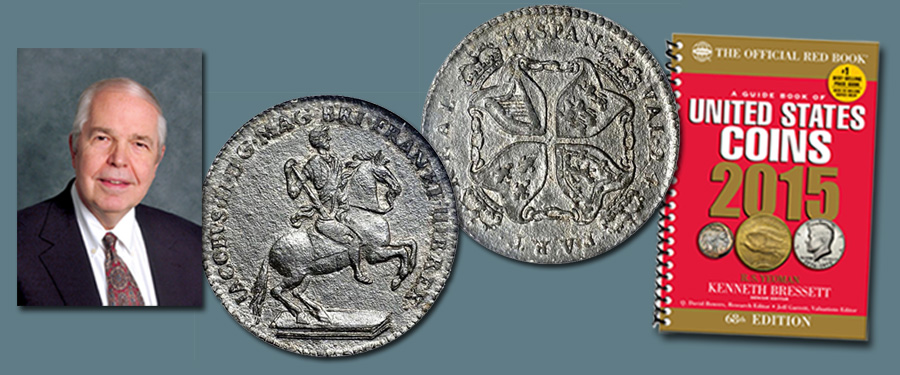
I continue my tour through the 2015 edition of A Guide Book of United States Coins, and encourage you to follow me. (The 2016 edition is now in circulation, but not widely distributed.) This week’s discussion is centered on page 41.
By way of background (as the focus for this week’s series, American Plantation tokens, is rather brief), I will give general commentary concerning the colonial series in general. The colonial era is defined as the years prior to the establishment of the United States of America, which can be set at 1776 and the Declaration of Independence, although the country on this side of the Atlantic remained under the British until the Revolutionary War ended in 1781, and the Treaty of Peace was signed in 1783. Prior to then, settlers from various European countries established footholds in America. The Spanish were dominant from South America through Mexico and into part of what is now the western United States. The British settled the eastern seaboard and the French were prominent in what today is Canada and also in Louisiana. Coinage of the British colonies in America form the subject of Guide Book listings and collector interest. Adopted into the colonial series in a way are coins relating to George Washington.
For many years the collecting of colonial coins was mainly limited to scholars and dedicated enthusiasts who drew upon Sylvester S. Crosby’s 1875 book The Early Coins of America, as a basic guide, supplemented by monographs and books on different specialties such as Vermont, Connecticut, Massachusetts and other series. Today in 2015 the interest is widespread. The Colonial Coin Collectors Club (C4), established in 1993, has grown to include hundreds of members and has its annual convention in conjunction with the Whitman Coin & Collectibles Expo in Baltimore in November. While some colonial coins are necessarily expensive due to their rarity, many of them are quite affordable, especially in comparison to federal coins of similar rarity. A glance through the Guide Book will show many pieces available in the low hundreds of dollars and even more if you include all below $1,000. While completion is desired in federal series, such as building collections of Indian Head cents, Morgan silver dollars, or commemorative silver, there is no such goal for colonial specialists. There are so many varieties that no one will ever get one each of the copper coins of Connecticut, 1785-1788, for example. Most are satisfied to get as many different major design types as they can.
Returning to this week’s topic, American Plantation tokens, these were authorized by King James II, who in August 1688 granted a patent or franchise to Richard Holt, an agent who represented the owners of several tin mines. Holt proposed that new issues for the plantations in America be made of tin and be of Spanish monetary designation to facilitate their acceptance in the New World. By that time Spanish-American coins were dominant. The value assigned to these pieces, 1/24th of a real was equal to about 1-1/2 farthings, or somewhere between a British quarter penny and half penny.
The dies were cut by John Rottier, one of England’s most famous engravers. In 1964 Eric P. Newman, a leading scholar in the colonial series, created a study for the American Numismatic Society that identified seven obverse and seven reverse die varieties, indicating that the coinage must have been extensive. He was not able to find anything about the distribution, and it is not thought that they were widely circulated in America, although one was excavated in Jamestown, Virginia.
The obverse of these tokens shows James II on horseback, surrounded by a Latin inscription. On the reverse are four heraldic shields. Today American Plantation tokens are occasionally encountered, most being restrikes made of Newman die combinations 4-E and the more plentiful 5-D. These were made in a pewter-like metal and not in nearly pure tin like the originals. Originals often display black oxidation called “tin pest” from the metal being subjected to low temperatures. Restrikes sometimes have oxidation, but mostly have bright surfaces. The rims are often irregular. While such pieces can be collected by varieties, most numismatists are satisfied to own one example to illustrate the type.





